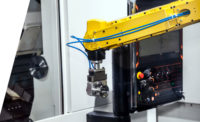ANN ARBOR, MI—Industrial robot orders in 2018 grew 24 percent over the previous year in the life sciences, food and consumer goods, plastics and rubber and electronics industries, according to the Robotics Industries Association. The main reasons are lower robot prices, and robot systems that are easier to install, integrate and program.
Over the past 30 years, the average price of an industrial robot has fallen by half, according to global management consultant McKinsey & Co. The average selling price of industrial robots decreased from $63,000 in 2009 to $45,000 in 2018, according to statista.com.
Equally important, robotics companies have added more functionality, notes Tom Fischer, director of operations for RobotWorx. One example of improved functionality is in the human-machine interface. Another example can be seen in collaborative robots.
“Their biggest use is in machine tending, that’s the hot one right now,” says Fischer. “You’re able to have an operator in the work cell with the robot working side-by-side.”
“[Robots are] better suited to a wider variety of applications,” notes Jason LeGrand, automation specialist at MC Machinery. “As a result, manufacturers are using them for more. What’s happening is that manufacturers are taking a stack of parts that are cut well and they’re being delivered to a place where robots can access them."
Once manufacturers have identified what robots can do to make operations more efficient and installed them on their plant floor, those manufacturers can take advantage of more intuitive and user-friendly software to program them.
Robotics companies have also made it easier to migrate from basic programming to more complicated tasks to integrate the increased functionality of the robot, depending on the job at hand,
Having some workers on hand will always be necessary, says Fischer. “Lights out is kind of a misnomer for production. You always have some support. But companies are going to skeleton crew automation.”


